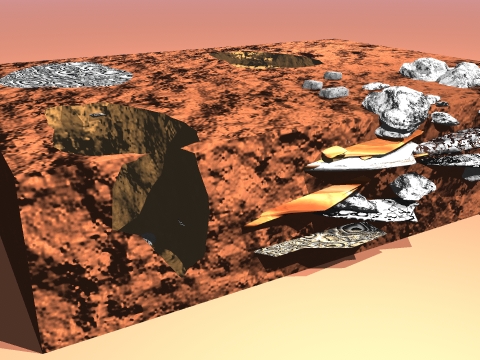The Virtual Meier Site
Features found in the Midden
 The midden, to the east of the plankhouse, was a low and irregular dome about a meter high and five meters in diameter. Six excavation units sampled the midden, exposing a wide variety of artifacts and organic remains, as in the plankhouse.
The midden, to the east of the plankhouse, was a low and irregular dome about a meter high and five meters in diameter. Six excavation units sampled the midden, exposing a wide variety of artifacts and organic remains, as in the plankhouse.
In plan view, most midden features are less distinct than those within the plankhouse. This appears to be because midden deposits represent a more haphazard deposition of materials than, for example, in the more formalized atmosphere of the plankhouse interior. In the vertical, however, stratigraphy in the midden is more distinct than in the plankhouse, as the midden was not as continually reworked as, for example, the pit deposits in the plankhouse. It is possible that, if we can consider the midden deposits reflective of activity within the plankhouse, we will be able to use midden deposits to roughly trace activity differences between the historic and prehistoric periods at Meier. Such traces would be coarse, however, and would be unable to distinguish between the activities of different ranks.
Pits were found in the midden; these were often rather shallow and amorphous and were never lined with planks as within the plankhouse. These pits contained, in general, dense deposits of animal bone, fire-cracked rock and ash. While we may expect that lithic debitage might have been dumped into special-purpose pits in the midden area (as has been reported among modern Lacandon Maya and Ethiopian obsidian workers, and archaeologically in Central Mexico), no such pits were found in the Meier middens (or within the plankhouse). This is a further line of evidence suggesting to me that what we archaeologists call 'debitage' is, at Meier, often actually a stockpile of raw material for further use. Generally, most chipped stone tools are less than 3cm in maximum dimension; much debitage falls into this category. At Meier, many tools are made on unmodified chips of stone which we may easily consider was simply picked from a pile of 'debitage'. I feel that the lack of discrete debitage dump pits, in the plankhouse, midden or outside the plankhouse and midden, suggests that we must be careful with our use of the word 'debitage'.
Hearth matrix is also found in non-hearth areas; in these areas, though, it is generally found in a disassociated state, scattered, appearing to be a dump of hearth matrix. The presence of such features in the midden units, as well as in exterior contexts, suggests periodic cleanout of the hearth bowls (described above). It appears that ash, charcoal and some sand, as well as fire-cracked rock, was periodically scooped up from hearth areas, and dumped in the midden, or at other extra-plankhouse areas. Some hearth dumps (illustrated above as amorphous but associated scatters of heath ash and sand) are found in pits in the plankhouse, near the hearth areas; hearths are not found near the benches. 'Destroyed hearths' are often found, near intact hearths, cut by postmolds and/or plankmolds.
Other features found in the midden include piles of fire-cracked rock (FCR) which derived from the hearth areas, or extra-plankhouse fire areas. Fire-cracked rock is found in quite high densities in the midden. Occasioally, post and plank molds were found cutting through midden deposits; this indicates the use of the midden area for some function, perhaps smoking or heat-treatment of materials using racks, the racks accounting for the structural features.
'Lenses' (thin, broad deposits) of shell, burnt earth, sand and ash were also encounered in the midden. These are, again, vertically distinct, but horizontally amorphous, indicating an 'offhand' dump of refuse, rather than repeated use of this material in the midden area. In sum, we may conclude that the lack of stratigraphic mixing, the lack of horizontal clarity, the presence of vertical clarity, and the lack of spatial redundancy among deposit types, all suggest that the midden area was used as a dumping area for plankhouse-associated debris. We note that some material debris generated outside the plankhouse may not have been dumped in the midden, and, in the same manner, perhaps not all material generated in the plankhouse was dumped in the midden. Nevertheless, the midden is an important element of the site for comparison with the plankhouse and extra-plankhouse analytical units.
Back to Features

